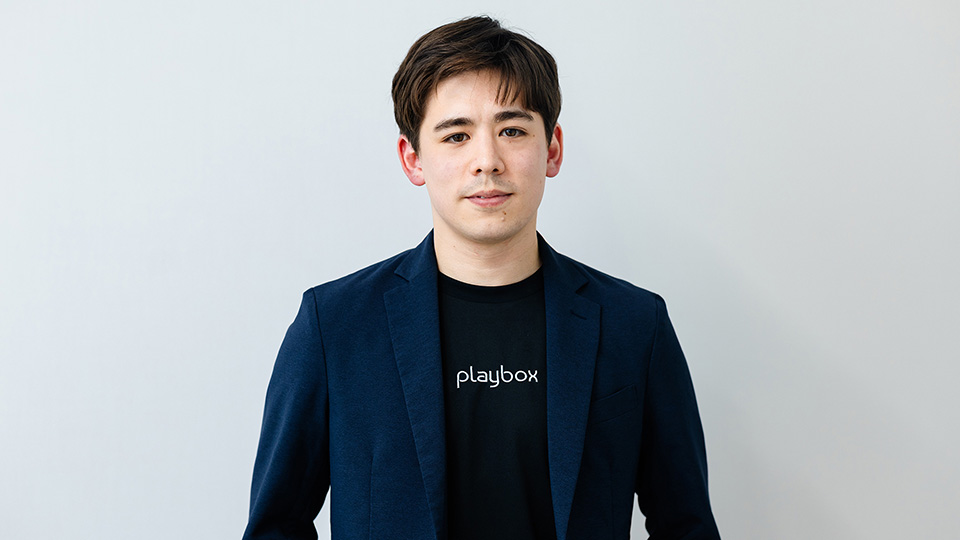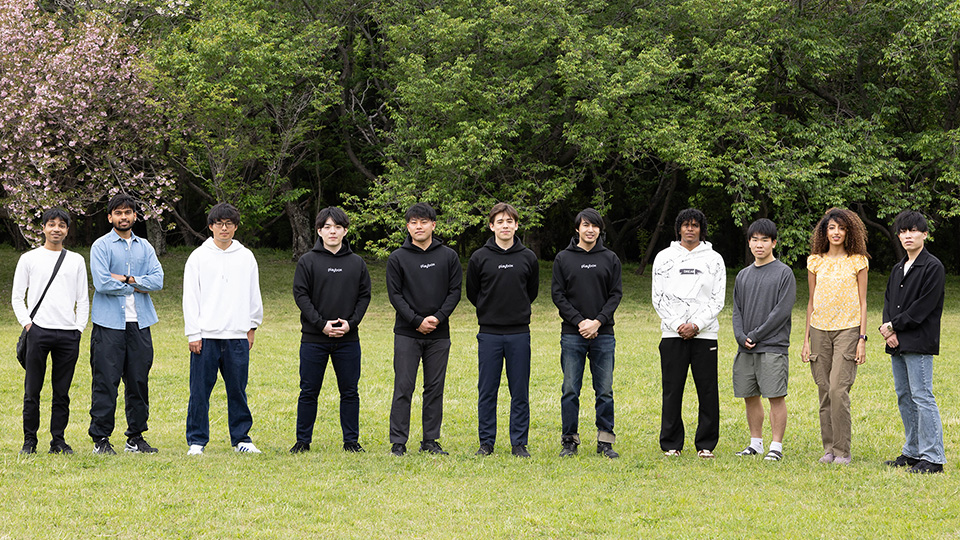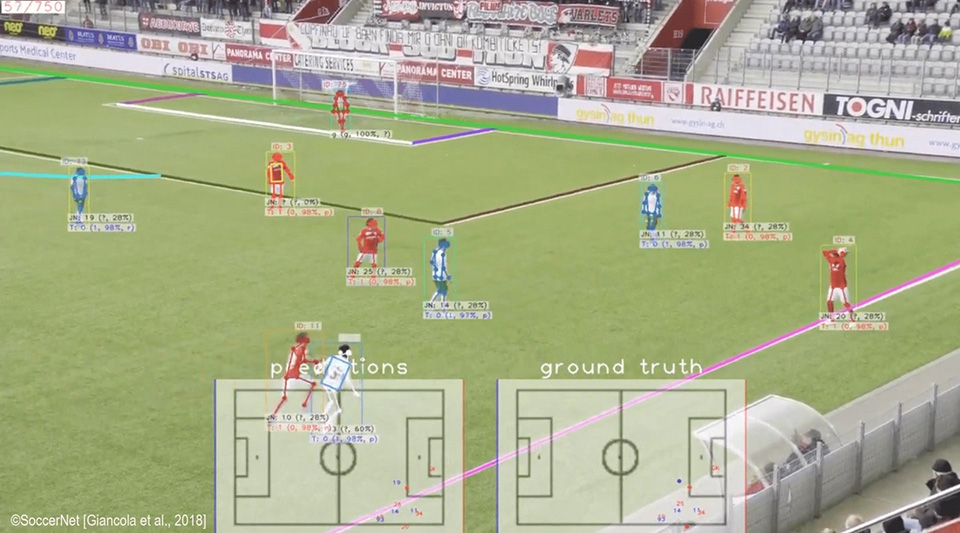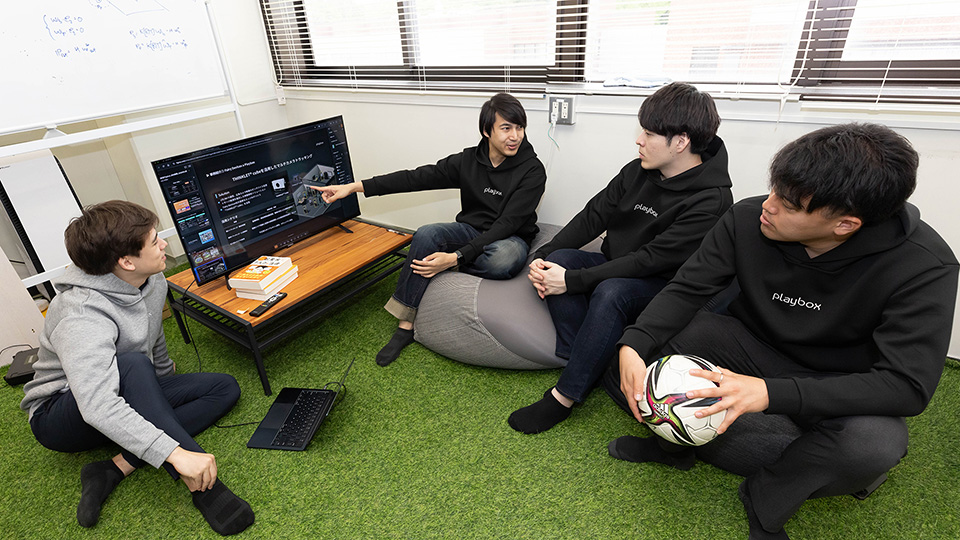- TOP
- About
- Affiliated League
- Information
- League Members
- Partners
- League Report
Search League Members
-
公式X
In the world of professional sports, collecting and analyzing game footage is increasingly vital for strategy and player selection. Team sports like soccer, in particular, require advanced video processing and AI technology to analyze the complex, intersecting movements of the ball and players.
However, this type of data analysis has largely been limited to professional use. Playbox Inc. aims to change that by "providing these AI-based video processing techniques and analytical know-how to amateurs at a low cost."
Atom Scott, CEO of Playbox Inc., has loved soccer since childhood and moved to Japan at age 10. After enrolling at the University of Tsukuba, he handled data analysis for the soccer club. He is currently a doctoral candidate at Nagoya University. While openly publishing algorithms and large-scale datasets from his research on team sports analysis, he has also transformed an advanced video analysis platform—once exclusive to professionals—into an accessible, low-cost service for everyone.
We spoke with him about how he overcame the high hurdles of funding and talent in video data analysis to make it accessible to amateurs, and about his future business plans.
 Atom Scott, CEO of Playbox Inc.
Atom Scott, CEO of Playbox Inc.Could you tell us about your origins in the sports tech field and the formative experiences that led you to launch this business?
Scott: I was born in London, UK, and grew up surrounded by soccer; I just loved it. My real starting point was a free research project in my first year of high school, based on an overseas curriculum. My theme was training methods and play analysis for getting better at soccer. I spent about a year writing a 100-page book, but it was just a summary of existing literature with no scientific basis, and it received a low grade.
So, the next year, I learned programming from my physics teacher and developed my own analysis software. I used a high-speed camera to try a scientific approach, comparing my kicking form with that of the Portuguese hero Cristiano Ronaldo.
It was a program to measure the velocity of each joint during a soccer kick. It required an enormous amount of time and effort—I had to manually plot all the joint points for about 100 frames of video and export that movement into Excel data. But from this experience, I learned how writing a program could streamline and automate tedious tasks, and I discovered how fascinating it was to 'analyze sports movements with a scientific approach.' I used this research to pass the self-recommendation entrance exam for the University of Tsukuba to study sports x IT, and I also joined the soccer club. --I hear that Kaoru Mitoma, who plays for Japan's national team, was in the same year as you at the Tsukuba soccer club.
Scott: Yes, he was. It was a powerhouse team back then, and I was both a player and the analyst. The coach was very cooperative about data utilization. We could have specific conversations like, "This number was bad," or "It would be great to have this analysis." That made me fully realize the need for data that was actionable at that high level.
Was that the inspiration for starting your business?
Scott: Actually, before we even got to data analysis, the sheer act of "capturing" game data was a huge burden on the front lines, both in terms of manpower and camera equipment. This "automation of data collection" became my research theme. In graduate school, I pursued methods for automatically acquiring and analyzing data using AI. I realized that if I could commercialize this research, I could make life more convenient for many people, and that led me to start the company.
The company was established in November 2024. Did you face any difficulties?
Scott: After three years of research, refining the product idea, and gathering a team, we were ready to commercialize.
So you had the technology, the idea, and the people. What was the final push to launch?
Scott: Securing a partnership with a specific company—namely, the collaboration with MIXI, Inc. to build a sports AI video analysis platform. It wasn't about "starting a company just to start one." We launched because "the clear purpose and timing for this business" had aligned.
So you seized the right opportunity. What about funding?
Scott: For the launch, we received funding from the Ministry of Economy, Trade and Industry's Mitou Program and the ICT Startup League (FY2023), gaining continuous support not just technically but also on the business side. Since we already had a team, incorporating was smooth; it was mainly about creating an organizational shell for us.
 The Playbox team members
The Playbox team membersPlease tell us about your current business pillars.
Scott: The core of our business is the "technology to make human movement computable from video and sensors," which we developed in-house. We are expanding based on two pillars.
What is the first pillar?
Scott: "AI Sports Products for Amateurs." We are developing low-cost products that use AI to solve problems, allowing anyone with just a smartphone to analyze their play, automatically generate highlights, and then edit and share them.
What does that look like?
Scott: The target is a broad range of amateurs, from elementary school students to weekend-warrior adults and semi-pros. The common challenge amateur soccer teams have always faced is the hassle of "filming," "editing," and "sharing" games, which is the prerequisite for data analysis. On top of that, they need experts to interpret the analysis results. --So your target is amateurs who lack the personnel for filming and editing, and who don't have the know-how or talent to use the analysis. How did you solve that problem?
Scott: We are considering providing a low-cost, easy-to-use filming product that requires minimal staff. For example, just by attaching a fisheye lens to a smartphone, you can capture about 90% of the pitch. You don't need expensive camera equipment or a lot of people to film. If they just upload the video as is, we can provide consistent analysis results using our proprietary video processing and AI technology.
To achieve this, we first had 40 amateur teams use the product on a trial basis, and they give us frequent feedback whenever there's an issue. Based on feedback from those 40 teams, the product is now undergoing significant improvements.
Why are you purposefully focusing on the low-cost amateur market?
Scott: Globally, the sports tech field is a red ocean, with many well-funded companies competing in the pro market. However, with the evolution of AI and an era where everyone has a smartphone or action camera, an opportunity has emerged to create products that are "cheaper, broader, and more accessible." The amateur domain still has few competitors, so we determined there is significant room for us to enter.
And the second pillar?
Scott: "Sports-Specific AI Solutions." This is a service we offer to corporations at a premium price point, providing customized software solutions for optimizing human movement and for visualization and analysis in entertainment and broadcasting.
What kind of companies are commissioning this?
Scott: We've naturally seen an increase in inquiries from a wide range of companies, including sports manufacturers, broadcast stations, and mega-ventures, all saying they "definitely want to use" our AI technology. This is proof that our technology is being recognized for its value in various applications—like enhancing broadcast entertainment, developing sports equipment (like shoes and rackets), and improving performance—and it's been a major breakthrough for us.
Could you give a specific example?
Scott: In terms of entertainment and media collaboration, besides the MIXI partnership, there's the basketball viewing experience at "Toyota Arena Tokyo," the new arena Toyota built in Odaiba. It's a system where AI generates live play-by-play commentary (AI audio description) tailored to the game's flow, allowing visually impaired individuals to enjoy watching sports. You can not only listen to the AI's audio commentary but also talk with it.
Talk with the AI?
Scott: For example, if the crowd in the arena cheers, you can ask the AI, "What was so great about that play?" just like you'd ask a basketball-savvy friend sitting next to you. It's equipped with a conversational function that allows the user to ask questions about why people are excited or what was impressive about the current play.
And how do you apply AI technology to the development of sports equipment?
Scott: It's "movement evaluation"—capturing and quantifying the characteristics of a person's movement when they wear shoes, rackets, or apparel. That data is then used in product development. This, too, is our "technology to make human movement computable from video and sensors."
This "technology to make human movement computable" can be applied to fields other than sports, can't it?
Scott: Most recently, we've been working with Shimizu Corporation on a project to track people's movements within an office building and use that information to control the HVAC system. This tracking technology can, of course, be applied to other fields. These applications also leverage our technology, which was honed by clearing the difficult challenge of "complex tracking of human movement" in sports.
 Successfully achieved a significant improvement in accuracy over existing methods in Game State Recognition (GSR), which identifies the role (field player, goalkeeper, referee, etc.) and position of each person from soccer game footage.
Successfully achieved a significant improvement in accuracy over existing methods in Game State Recognition (GSR), which identifies the role (field player, goalkeeper, referee, etc.) and position of each person from soccer game footage.This video analysis technology really is applicable to a wide variety of fields.
Scott: Our goal is to "become the world's number one sports tech company," but ever since my time analyzing soccer data, we've cherished our hypothesis of "making human movement computable." This technology takes data from video and converts it into a form that AI can understand and computers can analyze. It has so many applications. Whether you're creating entertainment or improving performance, you need data. We've been developing that technology all along. It's finally catching the eye of corporations, and I think we've had a breakthrough this past year in using that tech to build things.
Why are you still enrolled in graduate school after this breakthrough? Are your business and research separate?
Scott: My research theme in graduate school is in a similar field—"automation of data collection"—but I want the results of my research to be used by all sorts of people, so I make it all open source. As Peter Thiel says, good business ideas often come from cutting-edge technology. From that perspective, I want to always be in touch with cutting-edge technology, be able to understand it, and always be learning.
So you let everyone use your research results widely, and you monetize through AI solutions?
Scott: Precisely because it's such a technically difficult field, we can offer it as a premium service. There's almost no competition in Japan that can create customized solutions specifically for sports, whether for broadcasting or entertainment. Our strength is that we have many engineers who have specialized in AI sports technology for about 10 years, all the way through their doctoral programs.
What are your plans for the future?
Scott: The most important thing is that we, as a company, truly master the technology of "making human movement computable from video." If we can give AI eyes and a brain, and properly connect those two functions, we can create technology that can be used in even more places. We want to master that completely, and in the amateur sphere, we'll make good products cheap and available to a wide audience, while also improving our technology to a level that works at the very top.
Then, we'll put that powered-up technology back into the amateur products. We'll use the massive data accumulated there to level up again. If we can create that kind of virtuous cycle, I seriously believe we can become the world's number one sports tech company in five years.
Are there any other fields where this technology could be used, besides what we've discussed?
Scott: Tracking people in offices and the security field are options, but I'm also thinking about sports betting in the future. I'm from the UK, so sports betting is very familiar to me. If it's legalized in Japan, our current technology could develop a recommendation system using real-time data and AI. As a measure to make sports even more exciting, as a company that handles data, I definitely want to position us to be a part of that.
By the way, this is your second time being selected for the ICT Startup League, following FY2023. Is anything different compared to the last time?
Scott: Our original strength is technology, so we have a tendency to try and solve everything with technology. Reflecting on that, this time we wanted to seek guidance on other aspects. We joined hoping for support in finding the most efficient ways to solve our challenges with minimal effort—things like forming partnerships, figuring out sales strategies, and handling the finance side.
Did you receive the support you were hoping for?
Scott: We're receiving very robust support. For example, an experienced advisor came all the way to our office in Tsukuba to give us advice on solving our problems. There are also multiple seminars and networking events, allowing us to learn a lot about areas other than technology. I feel we're getting more opportunities for input and output, so I hope to make full use of all of them to grow the company.
 Continuing the daily challenge to become the world's number one company in the sports tech field.
Continuing the daily challenge to become the world's number one company in the sports tech field.Editor's Note
Mr. Scott gives back to society through his graduate school research, while simultaneously tackling the challenging field of data analysis for amateur sports—an area that seems difficult to monetize. This is only possible because of the profits from the AI solutions he provides to corporations.
He has a refreshing, forward-looking energy, wanting to reinvest the high-end AI solutions and advanced technology developed there back into the amateur market to drive further technical improvement. We caught a glimpse not only of his ambition for his technology and business but also of his commitment to tackling the common societal challenge of how to automate and save labor in the face of a future population decline. He also has a strong desire to provide exciting sports experiences in any environment, leveraging the unique strengths of software, which also meets the needs of a diversifying society.
It will be exciting to see just how far this university-launched startup—certified by both the University of Tsukuba and Nagoya University—can expand its business, centered on the core technology of "making human movement computable," even beyond the framework of sports tech.
■ICT Startup League
This is a support program that began in FY2023, originating from the Ministry of Internal Affairs and Communications' "Support Program for R&D in Startups with Potential."
The ICT Startup League supports startups through four pillars:
①R&D Funding / Hands-on Support
Provides up to 20 million yen in R&D funding as a subsidy. Additionally, the selection committee members involved in choosing the league members stay on to provide hands-on support and promote growth. For companies that a committee member "absolutely wanted to select," a "cheering" (osshi-katsu) style support system is built, where the committee member themselves continuously provides advice on the business plan and offers growth opportunities.
②Discovery & Nurturing
We provide opportunities for learning and networking to promote the business growth of league members.
We also work to discover those who aim to start businesses in the future, aiming to expand the base.
③Competition & Co-creation
It serves as a place for positive competition, much like a sports league, where startups learn together and spur each other on in a system to win the funding they truly need (up to 20 million yen). We also provide a place for co-creation, where league members can collaborate and expand their businesses through various opportunities, such as sessions with the selection committee members.
④Promotion
We collaborate with media to publicize the initiatives of our league members! By getting the word out about their businesses, we aim to expand opportunities for new matching and chances.
■Related Websites
Playbox Inc.
/
Playbox Inc. (LEAGUE MEMBER)
/
ICT Startup League